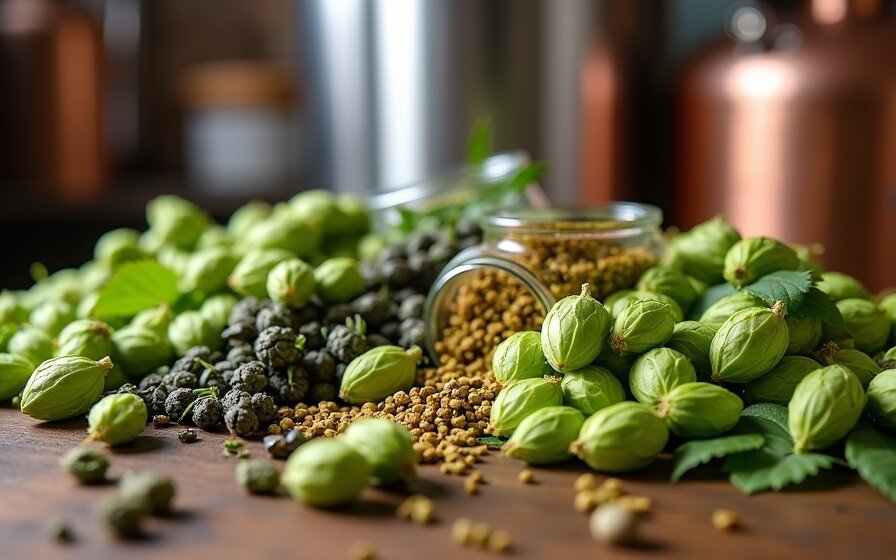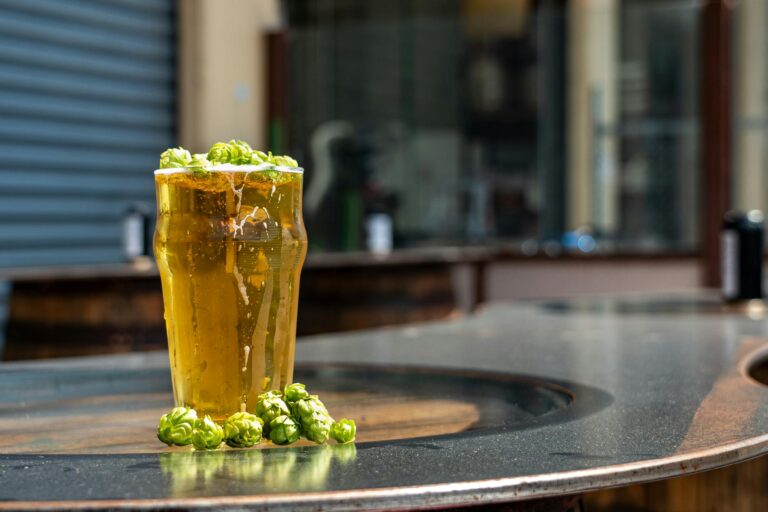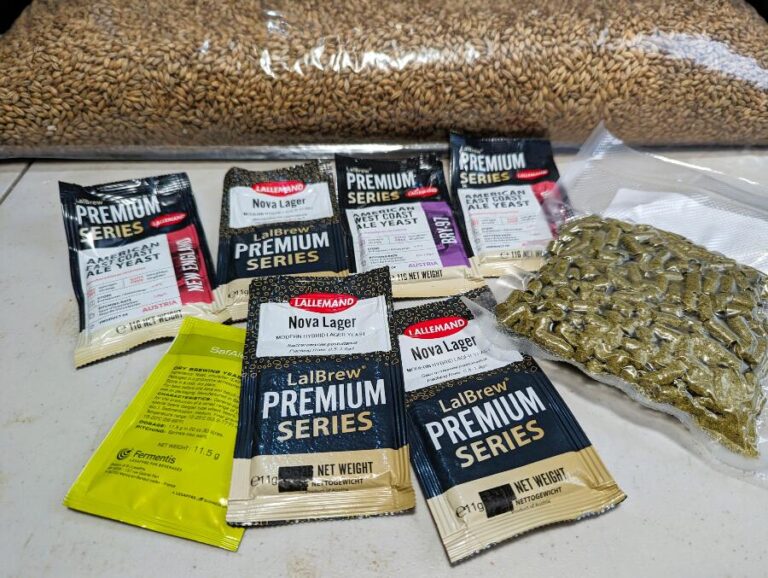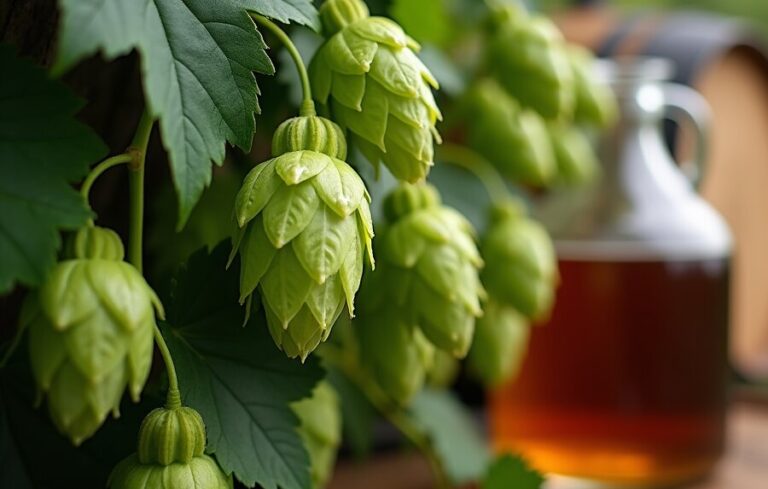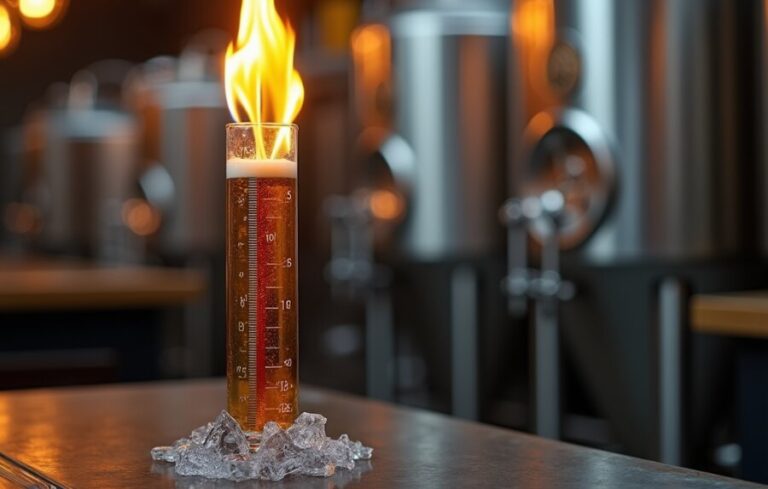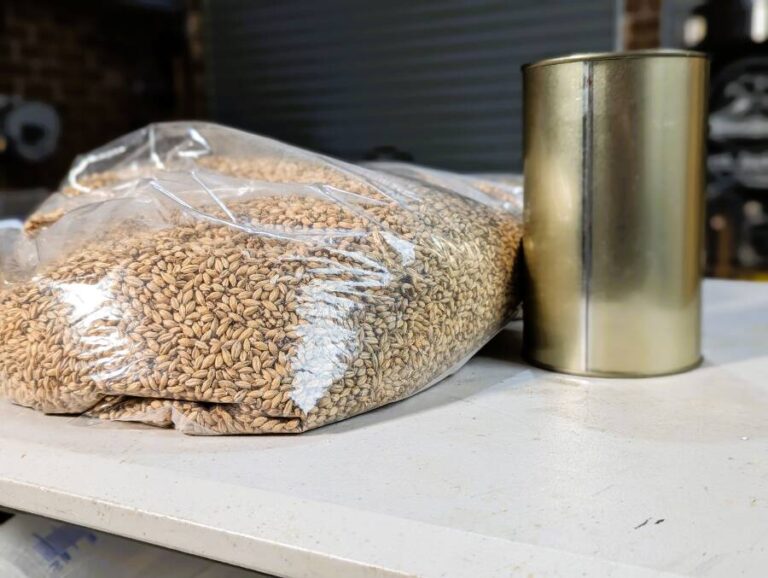Our evaluations and product assessments are conducted using a thorough and unbiased approach. Should you choose to buy any items through our provided links, we might receive a commission Read our disclosures.
Exploring Hop Substitutions for Homebrewing
Understanding Hop Varieties
In my journey of homebrewing, I’ve learned that understanding hop varieties is essential for creating the perfect brew. Hops come in many different types, each with unique characteristics that influence the flavour, aroma, and bitterness of the beer. By familiarizing myself with these varieties, I can make informed decisions about which hops to use and how to substitute them effectively.
Certain hops are known for their bittering properties, while others excel in adding aroma and flavour. This diversity means that I can often find alternatives for hard-to-obtain hops, allowing me to experiment without compromising quality. Resources like the HopUnion listing of hop varieties or hop acid charts can provide valuable guidance when I’m exploring potential substitutions (Homebrewing.org).
| Hop Variety | Key Characteristics |
|---|---|
| Citra | Citrus and tropical fruit aromas |
| Cascade | Floral and citrus notes |
| Magnum | Clean bitterness |
| Saaz | Earthy and spicy |
Importance of Hop Substitutions
Hop substitutions are a crucial aspect of homebrewing, especially when the alpha acid percentage of available hops differs from what a recipe calls for. When I encounter a situation where my hops do not match the recipe, I need to adjust to maintain the intended bitterness level. Calculating homebrewing bitterness units (HBUs) or alpha acid units (AAUs) can help me determine the right amount of hops to achieve the same bitterness in my beer (Homebrewing.org).
Many times, I’ve found that certain hop varieties have similar profiles, making them suitable alternatives. This flexibility allows me to keep brewing even when specific hops are out of reach. With some research and a good technique, I can consistently produce high-quality beer, even if I need to make substitutions (American Homebrewers Association).
By understanding hop varieties and the importance of substitutions, I can enhance my brewing experience and create delicious beers that reflect my personal taste. If you’re interested in the best hops to use, check out our guide on best hops for homebrewing.
Factors Influencing Bitterness
When I’m brewing my own beer, understanding the factors that influence bitterness is essential, especially when considering hop substitutions for homebrewing. Bitterness primarily comes from the alpha acids in hops, and knowing how these acids work can make a big difference in my brew.
Alpha Acid Content Impact
The alpha acid content in hops plays a crucial role in determining the bitterness of my beer. Different hop varieties have varying levels of alpha acids, which directly influence how bitter the final product will be. When I substitute one hop for another, I need to consider the alpha acid percentages to maintain the intended bitterness.
| Hop Variety | Alpha Acid Content (%) |
|---|---|
| Citra | 12 – 14 |
| Cascade | 4 – 7 |
| Magnum | 12 – 14 |
| Saaz | 3 – 5 |
If I substitute a hop with a higher alpha acid content for one with a lower content, I can use less of the new hop to achieve the same bitterness level. This not only keeps my beer’s flavour profile intact but also reduces the amount of hop debris in the kettle, which is beneficial for clarity (Beer and Gardening Journal).
Calculating Bitterness Units
Calculating the bitterness units is another important step in the brewing process. I often use International Bitterness Units (IBU) to measure the bitterness of my beer. When making hop substitutions, I calculate the amount of hops needed based on their alpha acid content to ensure that I reach the desired IBU level.
Here’s how the calculation typically works:
- Determine the IBU target for the beer recipe.
- Calculate the original hop’s contribution based on its alpha acid percentage and the volume of the brew.
- Find the new hop’s alpha acid content.
- Adjust the quantity of the new hop using a pro-rating method to maintain the same IBU level.
For example, if my original hop has an alpha acid content of 5% and I need to achieve 40 IBUs with 1 oz of that hop, but I’m substituting it with a hop that has 10% alpha acid content, I would use only 0.5 oz of the new hop to achieve the same bitterness (Homebrewing.org).
Understanding these aspects of hop substitutions not only helps me maintain the desired bitterness in my homebrew but also enhances the overall flavour and aroma profile of my beer. For more insights on different hop varieties, I often refer to articles on best hops for homebrewing and bittering hops for homebrewing.

Popular Hop Varieties
When it comes to brewing at home, understanding the different hop varieties can really enhance the flavour and aroma of my beer. Here are two popular hop varieties I often consider: Citra, Cascade, Magnum, and Saaz.
Citra and Cascade
Citra and Cascade hops are among the most sought-after options in the homebrewing community. In fact, they are used in over 15% of all recipes searched. Citra is especially dominant in IPAs, known for its bold citrus and tropical fruit flavours, making it a favorite for hop enthusiasts. On the other hand, Cascade hops are famously associated with the rise of IPAs in the 1980s and 1990s. They provide a floral and slightly spicy aroma, which pairs beautifully with Citra for a well-rounded brew (Beer Maverick).
| Hop Variety | Aroma Profile | Common Uses |
|---|---|---|
| Citra | Citrus, Tropical Fruits | IPAs, Pale Ales |
| Cascade | Floral, Spicy | Pale Ales, IPAs |
Individual preferences vary, and while I appreciate both hops, some brewers may choose to avoid Cascade to create a unique twist on classic recipes (Brew Your Own).
Magnum and Saaz
Magnum hops are known primarily for their bittering properties, making them an excellent choice for balancing the sweetness of malt in various beer styles. They are often used in the early stages of brewing to achieve the desired bitterness. Saaz hops, on the other hand, are traditionally used in Czech-style lagers and are prized for their earthy and herbal aroma. Both Magnum and Saaz can be great hop substitutions for homebrewing, depending on the beer style I’m aiming for.
| Hop Variety | Aroma Profile | Common Uses |
|---|---|---|
| Magnum | Earthy, Spicy | Bitterness in Ales and Lagers |
| Saaz | Herbal, Earthy | Czech-style Lagers |
I often find that combining these hops can yield a balanced beer with a delightful complexity. For more information on the best hops for homebrewing, check out our guide on best hops for homebrewing and discover the various hop flavours and their roles in brewing by visiting hop flavors in homebrewing.
Understanding these hop varieties helps me make informed choices in my brewing process, ensuring that each batch is a step toward perfecting my craft.
Practical Tips for Homebrewers
As I dive into the world of homebrewing, I often find myself exploring hop substitutions to enhance my brews. Here are some practical tips that I’ve picked up along the way.
Consulting Hop Resources
When it comes to finding suitable hop substitutes for my recipes, I make it a point to consult various resources. The HopUnion listing of hop varieties is a fantastic reference. It provides insights into different hop characteristics, making it easier for me to identify alternatives that offer similar flavours and aromas. Additionally, I often check out hop acid charts to compare alpha acid percentages. This information is crucial when selecting hops that will deliver the bitterness I’m aiming for.
| Resource Type | Example |
|---|---|
| Hop Variety Listings | HopUnion |
| Hop Acid Charts | Homebrewing.org |
| Homebrewer Communities | American Homebrewers Association |
Adjusting for Alpha Acid Content
Understanding the alpha acid content of my hops is essential, especially when making substitutions. If the alpha acid percentage of the hops I have on hand differs from what my recipe calls for, I need to adjust the amount accordingly. The key is to maintain the same International Bitterness Units (IBU) level in my beer.
I use a simple pro-rating calculation to figure out how much of the new hop to use. Here’s a quick example:
- Determine the IBU goal: Let’s say my recipe calls for 50 IBUs.
- Identify the original hops: If I’m substituting a hop with 5% alpha acids for one that has 10%, I would adjust the quantity needed.
- Calculate the new amount: If the original recipe called for 1 oz of the 10% alpha acid hop, I would need to double the amount of the 5% alpha acid hop to achieve the same bitterness.
This method ensures that I keep the bitterness consistent while experimenting with different hop varieties. For detailed calculations and tips about hop utilization, I recommend checking out our page on hop utilization in homebrewing.
By keeping these tips in mind, I can confidently explore hop substitutions for homebrewing, ensuring that my brews maintain the quality and flavour I strive for.
Expert Insights on Hop Substitutions
Homebrewers’ Forum Discussions
I often find invaluable insights in homebrewing forums, especially when it comes to hop substitutions for homebrewing. One of the most engaging discussions I came across was initiated by Riptide on October 22, 2017, in Massachusetts. Riptide shared his experiences with various hop varieties and sought advice on suitable alternatives when certain hops were unavailable. Participants from across the globe chimed in, sharing their own trials and successes.
Dave_S from England contributed to the conversation on May 18, 2017, highlighting his favorite hop substitutions that preserved the flavours he loved. Another user, DrivinNCryin from South Carolina, joined the chat on August 21, 2017, offering tips on adjusting bitterness levels when changing hop varieties.
The diversity of opinions and experiences in these forums really showcases how homebrewers adapt and innovate. I recommend checking out the full discussion on Beer Advocate to gain a broader understanding of how different brewers approach hop substitutions.
| Participant | Location | Date | Contribution |
|---|---|---|---|
| Riptide | Massachusetts | October 22, 2017 | Initiated discussion |
| Dave_S | England | May 18, 2017 | Shared favorite hop substitutions |
| DrivinNCryin | South Carolina | August 21, 2017 | Tips on adjusting bitterness |
| Bryan12345 | Texas | March 17, 2016 | Contributed insights on hop varieties |
| GormBrewhouse | Vermont | June 24, 2015 | Discussed unique hop combinations |
Brewer Recommendations
Many professional brewers also offer recommendations on hop substitutions based on their experiences. I recently read about several brewers who have experimented with various hop varieties to achieve specific flavour profiles. For example, switching from Citra to Mosaic hops can result in a more complex aroma without sacrificing the quality of the brew.
Brewers often suggest starting with a similar alpha acid content when substituting hops to maintain the intended bitterness. For instance, if you are using a bittering hop like Magnum, which typically has a higher alpha acid content, you might look for a substitution with a comparable level, such as Columbus or Simcoe.
For those curious about hop flavours, I recommend checking out resources on hop flavors in homebrewing to understand how various hops can affect the taste of your beer. Additionally, exploring bittering hops for homebrewing can help identify suitable alternatives that match your brewing goals.
Incorporating the insights from both forum discussions and professional recommendations can lead to exciting new flavours and experiences in your homebrewing journey. Using these resources, I feel more equipped to experiment with hop substitutions and enhance my brew.
Enhancing Beer Profiles
Creating the perfect brew involves not just selecting the right hops but also understanding how to pair different hop varieties and achieve the desired aromas. These aspects can greatly influence the overall character of my homebrew.
Pairing Hop Varieties
When I think about pairing hop varieties, I consider the type of beer I’m brewing and the intensity of hop character I want to achieve. It’s essential to pair hops with similar characteristics that complement one another, as this helps avoid one variety overpowering the flavour and aroma profile of my brew. According to Brew Your Own, using two to three hop varieties is optimal to avoid a “muddy” effect on the palate and nose.
| Beer Type | Suggested Hop Pairings |
|---|---|
| Pale Ale | Citra, Cascade, Simcoe |
| IPA | Mosaic, Amarillo, Centennial |
| Stout | Fuggle, East Kent Goldings, Willamette |
| Lager | Saaz, Hallertau, Tettnanger |
By limiting the number of hop varieties, I ensure a balanced profile where each hop can shine without creating an overwhelming mix. This approach is particularly useful when I’m experimenting with new recipes.
Achieving Desired Aromas
To achieve the desired aromas in my beer, I focus on matching the characteristics of the original hop with the new variety when making substitutions. This can involve comparing oil compositions or descriptors provided by suppliers. Smelling the hops and referencing my past brewing records for successful substitutions are also effective strategies (Brew Your Own).
It’s important to remember that substituting a hop variety means my beer will taste different, even if I think I’m making a one-for-one swap. This difference may be subtle in less hop-forward beers, but in hop-centric styles, the change will be noticeable (Beer and Gardening Journal).
| Original Hop | Suggested Substitution | Expected Aroma |
|---|---|---|
| Citra | Galaxy | Citrus, tropical fruit |
| Cascade | Amarillo | Floral, citrus |
| Saaz | Hallertau | Spicy, earthy |
| Simcoe | Mosaic | Pine, tropical, berry |
By carefully selecting and pairing hop varieties, I can enhance the flavour and aroma profile of my homebrew, making each batch unique and enjoyable. For more information on specific hop flavours, check out our article on hop flavors in homebrewing.


